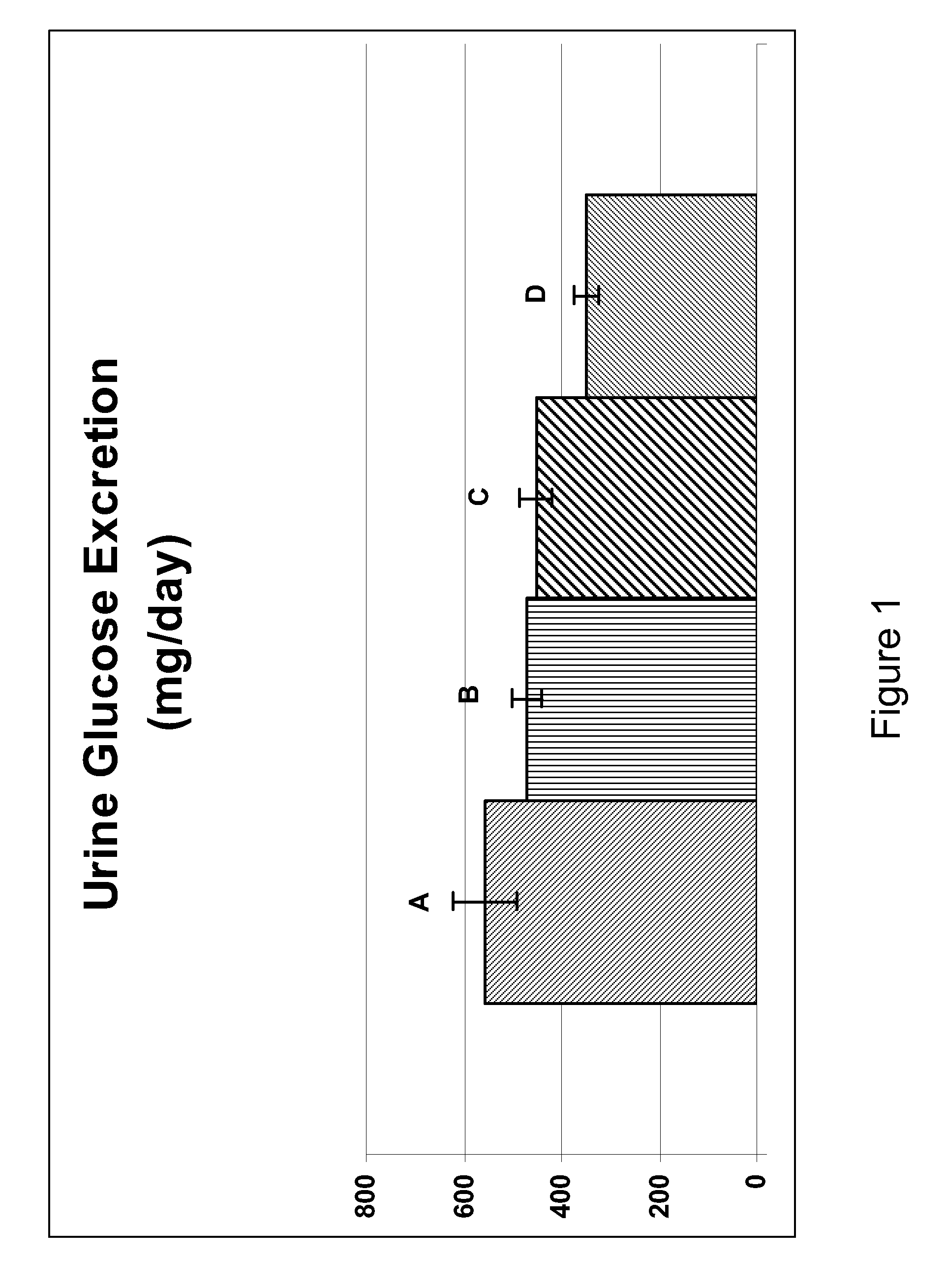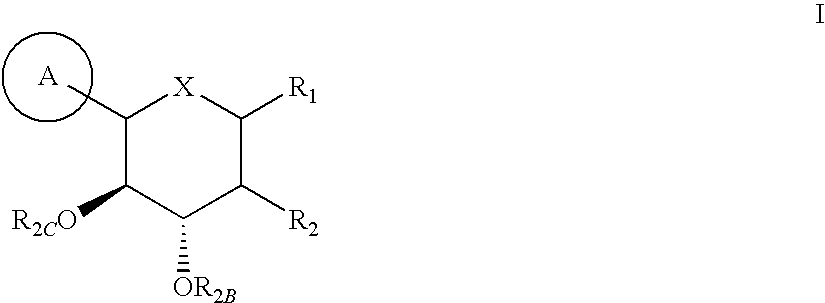Inhibitors of sodium glucose co-transporter 2 and methods of their use
a sodium glucose co-transporter and inhibitor technology, applied in the field of methods of treating metabolic diseases and disorders, can solve the problems of becoming increasingly difficult for potential drug inventors to find unexplored chemical spa
- Summary
- Abstract
- Description
- Claims
- Application Information
AI Technical Summary
Benefits of technology
Problems solved by technology
Method used
Image
Examples
example 1
6.1. Example 1
Synthesis of (2S,3R,4R,5S)-2-[4-Chloro-3-(4-ethoxy-benzyl)-phenyl]-6-methoxy-tetrahydro-pyran-3,4,5-triol
[0135]
[0136]The captioned compound was prepared in several steps.
[0137]A. Preparation of [(3aS,5S,6R,6aS)-6-(tert-butyl-dimethyl-silanyloxy)-2,2-dimethyl-tetrahydro-furo[2,3-d][113]dioxol-5-yl]-methanol. This compound was synthesized using procedures known in the art. See, e.g., Nucleosides Nucleotides, 20:649-652 (2001) and references therein.
[0138]B. Preparation of (3aS,5R,6R,6aS)-6-(tert-butyl-dimethyl-silanyloxy)-2,2-dimethyl-tetrahydro-furo[2,3-d][133]dioxole-5-carbaldehyde. To a solution of oxalyl chloride (0.76 ml, 8.7 mmol) in CH2Cl2 (55 ml) under N2 at −78° C. was added dropwise a solution of DMSO (0.84 ml, 11.8 mmol) in CH2Cl2 (5 ml). After 15 minutes, the alcohol from step A (2.40 g, 7.9 mmol) in CH2Cl2 (20 ml) was added dropwise. After 15 minutes, NEt3 was added slowly. The reaction was allowed to warm slowly to room temperature over 105 minutes, then qu...
example 2
6.2. Example 2
Synthesis of (3S,4R,5R,6S)-6-[4-Chloro-3-(4-ethoxy-benzyl)-phenyl]-tetrahydro-pyran-2,3,4,5-tetraol
[0144]
[0145]The alcohol from Example 1, step D (51 mg, 0.093 mmol) was treated with 1:1 AcOH:H2O (1 ml) at 80° C. in a sealed vial for 18 hours. The reaction was cooled to room temperature, diluted with EtOAc to transfer to a flask, and concentrated under vacuum. The residue was dissolved in CH2Cl2, treated with NaHCO3 and MgSO4 for 30 minutes, filtered, and concentrated under vacuum. The product was purified by flash chromatography (4 g SiO2, 0-12% MeOH: CH2Cl2, 30 minutes, 10 ml / min), suspended in H2O, and lyophilized to give (3S,4R,5R,6S)-6-[4-chloro-3-(4-ethoxy-benzyl)-phenyl]-tetrahydro-pyran-2,3,4,5-tetraol (31 mg, 0.079 mmol, 85%) as a white solid. NMR revealed a 1:1 ratio of α and β anomers.
[0146]1H NMR (400 MHz, methanol-d4) δ ppm 7.34 (dd, J=8.08, 4.04 Hz, 1H), 7.22-7.30 (m, 2H), 7.09 (d, J=8.34 Hz, 2H), 6.80 (d, J=8.08 Hz, 2H), 5.16 (d, J=3.79 Hz, 1H α), 4.65 (...
example 3
6.3. Example 3
Synthesis of (2S,3R,4R,5S)-2-[4-Chloro-3-(4-ethoxy-benzyl)-phenyl]-6-ethoxy-tetrahydro-pyran-3,4,5-triol
[0147]
[0148]A solution of 0.35 M HCl in EtOH was prepared by adding AcCl (0.025 ml, 0.35 mmol) to EtOH (1 ml) and stirring for 15 minutes The alcohol from Example 1, step D (61 mg, 0.11 mmol) was treated with this solution for 2 hours at 80° C. in a sealed vial. The reaction cooled to room temperature, quenched with concentrated NH4OH until basic, treated with NaHCO3 for 30 minutes, diluted with CH2Cl2, filtered, and concentrated under vacuum. The product was purified by flash chromatography (4 g SiO2, 0-10% MeOH: CH2Cl2, 40 minutes, 10 ml / min), suspended in H2O, and lyophilized to give (2S,3R,4R,5S)-2-[4-Chloro-3-(4-ethoxy-benzyl)-phenyl]-6-ethoxy-tetrahydro-pyran-3,4,5-triol (40 mg, 0.095 mmol, 85%) as a white solid. NMR revealed a 1.75:1 ratio of α and β anomers.
[0149]1H NMR (400 MHz, Chloroform-d) δ ppm: 7.28-7.32 (m, 1H), 7.14 (m, 2H), 7.02 (d, J=8.84 Hz, 2H), 6...
PUM
| Property | Measurement | Unit |
|---|---|---|
| temperature | aaaaa | aaaaa |
| temperature | aaaaa | aaaaa |
| temperature | aaaaa | aaaaa |
Abstract
Description
Claims
Application Information
 Login to View More
Login to View More - R&D
- Intellectual Property
- Life Sciences
- Materials
- Tech Scout
- Unparalleled Data Quality
- Higher Quality Content
- 60% Fewer Hallucinations
Browse by: Latest US Patents, China's latest patents, Technical Efficacy Thesaurus, Application Domain, Technology Topic, Popular Technical Reports.
© 2025 PatSnap. All rights reserved.Legal|Privacy policy|Modern Slavery Act Transparency Statement|Sitemap|About US| Contact US: help@patsnap.com



